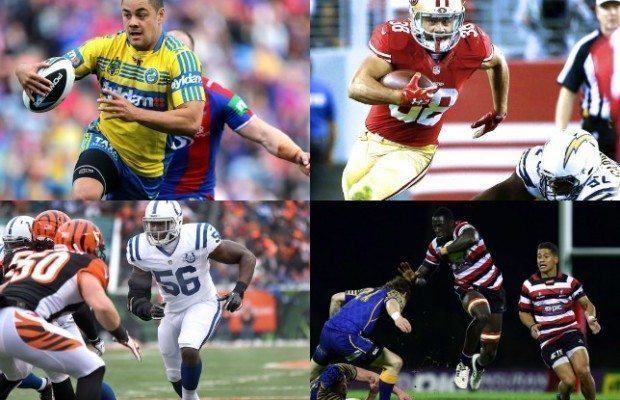Can Rugby Players be Good Football Players?

Could Rugby Players Cut it in Football?
On the face of it, rugby and American football have a lot in common. But can rugby players cut it in the NFL?
American Football and Rugby – Similarities
Superficially, American football and rugby appear to be practically identical with the most obvious difference being the helmets and padding. There are multiple different rugby codes (Union, League, and Aussie Rules) and players shift between them on a fairly regular basis, so could the same happen with American football?
There are some major similarities between the two sports. The playing fields are more or less the same dimensions, and players are required to be in fantastic physical condition. In addition, the ball (a prolate spheroid if you want to be fancy about it) is a similar shape, designed to be easier for catching, throwing, and carrying than the spherical ball used in soccer. But there are a large number of pretty hefty differences too.
COVID-19 Downtime and Online Casino Uptime
One unfortunate aspect that rugby and American football have in common is that both have been dramatically affected by the COVID-19 lockdowns and continuing aftereffects of the virus. Fans who have to endure further restrictions, or who just want an additional diversion to fill leisure hours or halftime breaks, can always enjoy the sports-themed games available at online casinos. The best casino options for North Americans and Canadians have plenty of slots and table games to entertain, in addition to introductory bonuses to welcome new players. Not only that, the best online casinos often come with virtual sports so that should the real deal be cancelled, delayed, or otherwise affected by real-world woes then sports fans can still experience the next best thing.
Differences Between American Football and Rugby
One of the most visible differences between American football and rugby is the protective gear (helmets and padding) worn in the former. This, coupled with the fact that blocking is prohibited in rugby, drastically alters the way players in one sport learn how to tackle. The lack of protection and more careful technique (to avoid injuring oneself as much as the other player) makes players shifting from American football to rugby in need of perhaps greater guidance early on than vice versa, as high collision speeds of enormously strong individuals has obvious potential for serious harm if not executed correctly.
Strategy and pace are another combined massive difference. While the protection afforded by the padding means American footballers can put in huge hits, the very frequent breaks compared to the more free-flowing and continuous exertion of rugby means that far greater aerobic fitness is needed for rugby. There’s more spontaneity in the latter, while the former involves far more planning and memorization of strategic plays. Likewise, rugby involves two halves of 40 minutes apiece, whereas American football comes with four quarters of 15 minutes each.
Passing is another critical difference. Pass the ball forwards in American football and that’s fine. Do it in rugby and you’ve broken rule number one and made yourself look like an idiot. Backwards (or sideways) passes are all that’s permitted in rugby. Get this wrong and the opposing team will be awarded a scrum.
Beyond rule changes, a player shifting from rugby to American football should already be in good enough shape when it comes to aerobic fitness. The difficulty might come with the reduction in free-flowing play and the emphasis on plays over spontaneity (beyond the obvious need to learn the substantial rule differences).
Rugby in America
Although clearly in the shadow of gridiron, rugby has been slowly growing in popularity in America and the national team’s now a regular at the World Cup. There are plans afoot for a 2022 National Rugby Football League to launch in North America, taking advantage of existing stadia and NFL fans to make a splash on the sporting scene. Rugby’s World Cup is the third biggest sporting extravaganza, behind only the Olympics and FIFA World Cup, and there’s clearly scope for dramatically increased US interest in the sport.
Should all go well, more rugby players will burst onto the scene. That should increase cross-sport migration due to the sheer earning power of NFL, in the same way that in the United Kingdom rugby league players often shift across to rugby union (which has deeper pockets), with former England star Jason Robinson being a stand out example of a successful code change.
In addition to the future looking bright for rugby, there have already been players shifting from the sport to American football. An early example of this was Tyrese Johnson-Fisher, from the UK, who became the first player based outside the US invited to participate in the Under Armour All-America High School Football Game.
Naturally, these attempts have had mixed results. Valentine Holmes’ efforts to join the NFL didn’t go far, although Christian Scotland-Williamson, formerly of Worcester Warriors, spent a number of years with the Pittsburgh Steelers. Another British example is Christian Wade, a former England rugby union international now signed up with the NFL’s Buffalo Bills.
All in all, it isn’t as easy to hop from rugby to American football as it might seem, as the superficial similarities do mask some significant differences. However, it’s entirely possible, and if the NRFL takes off in North America then we can expect to see a lot more players switching sports.